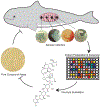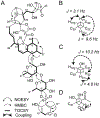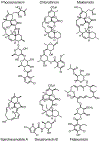Marine Mammal Microbiota Yields Novel Antibiotic with Potent Activity Against Clostridium difficile
- PMID: 29043783
- PMCID: PMC6530793
- DOI: 10.1021/acsinfecdis.7b00105
Marine Mammal Microbiota Yields Novel Antibiotic with Potent Activity Against Clostridium difficile
Abstract
The recent explosion of research on the microbiota has highlighted the important interplay between commensal microorganisms and the health of their cognate hosts. Metabolites isolated from commensal bacteria have been demonstrated to possess a range of antimicrobial activities, and it is widely believed that some of these metabolites modulate host behavior, affecting predisposition to disease and pathogen invasion. Our access to the local marine mammal stranding network and previous successes in mining the fish microbiota poised us to test the hypothesis that the marine mammal microbiota is a novel source of commensal bacteria-produced bioactive metabolites. Examination of intestinal contents from five marine mammals led to the identification of a Micromonospora strain with potent and selective activity against a panel of Gram-positive pathogens and no discernible human cytotoxicity. Compound isolation afforded a new complex glycosylated polyketide, phocoenamicin, with potent activity against the intestinal pathogen Clostridium difficile, an organism challenging to treat in hospital settings. Use of our activity-profiling platform, BioMAP, clustered this metabolite with other known ionophore antibiotics. Fluorescence imaging and flow cytometry confirmed that phocoenamicin is capable of shifting membrane potential without damaging membrane integrity. Thus, exploration of gut microbiota in hosts from diverse environments can serve as a powerful strategy for the discovery of novel antibiotics against human pathogens.
Keywords: cytological profiling; drug discovery; microbiome; natural products; porpoise.
Conflict of interest statement
Conflict of Interest
There are no competing interests.
Figures





Similar articles
-
Antibacterial and antibiotic potentiating activities of tropical marine sponge extracts.Comp Biochem Physiol C Toxicol Pharmacol. 2017 Jun;196:81-90. doi: 10.1016/j.cbpc.2017.04.001. Epub 2017 Apr 7. Comp Biochem Physiol C Toxicol Pharmacol. 2017. PMID: 28392375
-
Discovery and development of kibdelomycin, a new class of broad-spectrum antibiotics targeting the clinically proven bacterial type II topoisomerase.Bioorg Med Chem. 2016 Dec 15;24(24):6291-6297. doi: 10.1016/j.bmc.2016.04.043. Epub 2016 Apr 22. Bioorg Med Chem. 2016. PMID: 27143131
-
Natural products as a source of drug leads to overcome drug resistance.Future Microbiol. 2015;10(11):1711-8. doi: 10.2217/fmb.15.67. Epub 2015 Oct 30. Future Microbiol. 2015. PMID: 26517443 Review.
-
Gut bacteria of animals/pests living in polluted environments are a potential source of antibacterials.Appl Microbiol Biotechnol. 2019 May;103(10):3955-3964. doi: 10.1007/s00253-019-09783-2. Epub 2019 Apr 2. Appl Microbiol Biotechnol. 2019. PMID: 30941460 Review.
-
An In Vitro Model of the Human Colon: Studies of Intestinal Biofilms and Clostridium difficile Infection.Methods Mol Biol. 2016;1476:223-34. doi: 10.1007/978-1-4939-6361-4_17. Methods Mol Biol. 2016. PMID: 27507345
Cited by
-
Naturally Occurring Organohalogen Compounds-A Comprehensive Review.Prog Chem Org Nat Prod. 2023;121:1-546. doi: 10.1007/978-3-031-26629-4_1. Prog Chem Org Nat Prod. 2023. PMID: 37488466 Review.
-
Phocoenamicins B and C, New Antibacterial Spirotetronates Isolated from a Marine Micromonospora sp.Mar Drugs. 2018 Mar 16;16(3):95. doi: 10.3390/md16030095. Mar Drugs. 2018. PMID: 29547589 Free PMC article.
-
Exploring Micromonospora as Phocoenamicins Producers.Mar Drugs. 2022 Dec 7;20(12):769. doi: 10.3390/md20120769. Mar Drugs. 2022. PMID: 36547916 Free PMC article.
-
New Phocoenamicin and Maklamicin Analogues from Cultures of Three Marine-Derived Micromonospora Strains.Mar Drugs. 2023 Aug 7;21(8):443. doi: 10.3390/md21080443. Mar Drugs. 2023. PMID: 37623724 Free PMC article.
-
Addition of insoluble fiber to isolation media allows for increased metabolite diversity of lab-cultivable microbes derived from zebrafish gut samples.Gut Microbes. 2020 Jul 3;11(4):1064-1076. doi: 10.1080/19490976.2020.1740073. Epub 2020 Mar 22. Gut Microbes. 2020. PMID: 32202200 Free PMC article.
References
-
- Turroni S, Brigidi P, Cavalli A, and Candela M (2017) Microbiota-Host Transgenomic Metabolism, Bioactive Molecules from the Inside. J.Med. Chem DOI: 10.1021-acs.jmedchem.7b00244. - PubMed
-
- Abdelmohsen UR, Bayer K, and Hentschel U (2014) Diversity, abundance and natural products of marine sponge-associated actinomycetes. Nat. Prod. Rep 31, 381–399. - PubMed
Publication types
MeSH terms
Substances
Grants and funding
LinkOut - more resources
Full Text Sources
Other Literature Sources
Medical

